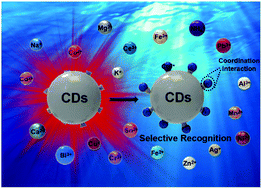Fingerprint identification of copper ions with absorption and emission dual-mode responses by N,S co-doped red carbon dots†
Abstract
Research interest in applying fluorescent carbon dots (CDs) to construct sensing platforms for metal ions has drawn increasing attention recently because of the outstanding optical and chemical properties of CDs. However, traditional recognition methods are almost focused on the single fluorescence mode and the interference from competitive metal ions can hardly be fully avoided. It is highly desirable to develop multiple-mode detection methods to guarantee the detection accuracy. Here, heteroatom N,S-co doped red emissive carbon dots (R-CDs) with high photoluminescence quantum yield (∼23%) were prepared for sensing copper ions (Cu2+) selectively. Besides the fluorescence quenching effect by Cu2+, the change in the UV-vis absorption spectrum has been explored as an additional and exclusive sign for binding of Cu2+. Then, the unique coordination-assisted quenching mechanism was suggested to be responsible for both fluorescence quenching and absorption change. Furthermore, the highly selective and sensitive detection paper for Cu2+ has been efficiently developed. This work will pave the way toward sensing trace metal ions.



 Please wait while we load your content...
Please wait while we load your content...